I took advantage of one of the last "extra" opening days the V&A is offering for its musical instruments gallery to check out the fuss. Having been sitting on the fence - sympathetic to the pleas for historic fashion displays, though drawn by my background as a violist and pianist to the music side - I came out fuming.
Yes, musical instruments are about playing (an argument that some are using to closet them away in congenial stately homes like Hatchlands for occasional performing upon for select audiences) but the overwhelming effect of those instruments is that man will go to irrationally ingenious lengths in pursuing an unknown aesthetic absolute - and that really is a V&A matter.
Museums are places for associations to be sprung on one. When I pulled out one of the heavy storage drawers containing a dusty, almost black dulcimer I suddenly remembered: “A damsel with a dulcimer/ In a vision once I saw...” Samuel Taylor Coleridge’s woozy words in Kubla Khan have never failed to whet my curiosity - and here is this functional, odd-sided box. What could be poetic about that? So listen to this damsel with this dulcimer (Dizzi, and her website), and marvel at the haunting, delicate penetration of the sound. Easy to imagine that blackened box sending its insidious harmonic messages out across a valley.
At the Edinburgh Festival a couple of years ago there was a loft installation by some Canadian artists of the kind of resonance that clings to even the most over-challenged memory, using pressure pads underfoot to trigger evocative sounds as you looked at old maths books or worn nursery chairs. I wonder why on earth the V&A doesn’t have a musical gallery with pressure pads - so that, like the man in the Radio 3 TV ad, you can suddenly find your stray footstep causing the curious old instrument in front of you to utter its music from three centuries ago.
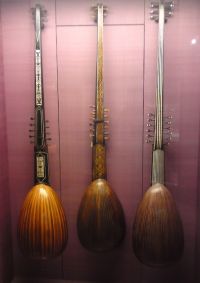 How could anyone looking at the variations of citterns and viols not be astounded by man’s sheer persistence at refining the sound from the plucking or stroking of the steeped, scraped, drawn, burned and tightly twisted intestines of a sheep? Who started that? Instrument-makers obsessed century after century with the combination of a bulb-shaped sonorous wood bottom, to sit in the lap, and a finger-board with a convolution of 24 strings, or 10, or seven, or six, or five, or even (in the bell marine) one - some emitting sympathetic harmonies with hidden strings inside the instrument, others pouring all concentration of sweetness into the subtle stroking of a bow of horse-hair so that it should awaken one carefully tightened string into melody.
How could anyone looking at the variations of citterns and viols not be astounded by man’s sheer persistence at refining the sound from the plucking or stroking of the steeped, scraped, drawn, burned and tightly twisted intestines of a sheep? Who started that? Instrument-makers obsessed century after century with the combination of a bulb-shaped sonorous wood bottom, to sit in the lap, and a finger-board with a convolution of 24 strings, or 10, or seven, or six, or five, or even (in the bell marine) one - some emitting sympathetic harmonies with hidden strings inside the instrument, others pouring all concentration of sweetness into the subtle stroking of a bow of horse-hair so that it should awaken one carefully tightened string into melody.
Listen to Joseph Sobol playing a 10-string cittern in relatively modern folk style, showing off the delicious harmonic variety that intricately imagined and hardly altered instrument produces.
Or take the awkwardness of a zither, half guitar, half harp - with a fingerboard of strings picked by one hand, and others lying alongside to be stroked by the second hand. It is as discoordinated as patting the head and stroking the stomach. And as if the maker knows what a toolkit this instrument looks, he’s got a painter in to decorate its boards tentatively with a pair of peasant lovers, and a fox skulking through the herbaceous border. But I seethe with curiosity to know what this old box sounds like. And I wonder how many of these more ornery instruments, with little to draw the visitor's glazed eye, will end up in a skip.
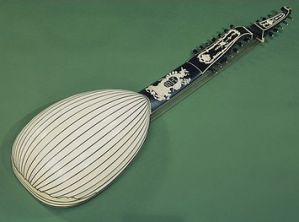 An exorbitant, gluttonously decorated theorbo such as the famous J H Goldt treasure of the V&A, with ivory whirlwinds storming amorously down its spine and flirtatiously pierced fingerboard, demands to be languidly plucked by a serenader in a hat, while being painted by an artist in an even more florid hat. Nothing could be more beseeching for a ghostly thread of its sound to touch one’s ear as one looks at it.
An exorbitant, gluttonously decorated theorbo such as the famous J H Goldt treasure of the V&A, with ivory whirlwinds storming amorously down its spine and flirtatiously pierced fingerboard, demands to be languidly plucked by a serenader in a hat, while being painted by an artist in an even more florid hat. Nothing could be more beseeching for a ghostly thread of its sound to touch one’s ear as one looks at it.
The same question silently rings out from Michael Rauche's elegantly self-advertising ivory-clad lute of 1762 London (pictured left, © V&A), the confident London of young Gainsborough (see main picture) and of Robert Adam as he built Syon House. A flamboyantly noticeable instrument that probably speaks with a deceptive, soft sound - as compared with the plain little brown violin in a nearby case, a 1699 Stradivarius from the year before Strad hit his stride, and almost certain to be capable of a huge, throbbing, golden violin sound in the right hands.
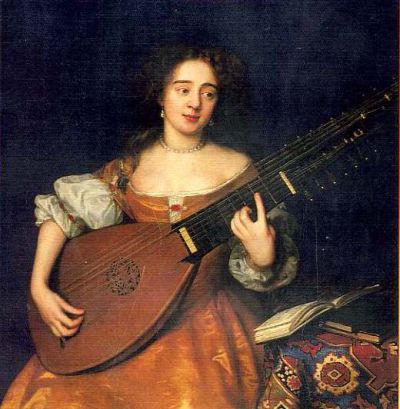 But now look at those theorbos and viols with a cold, mechanical eye, at the exquisite precision of the mechanics of intonation, the myopia-inducing exactness of the cogs meshing around each peg that controls the tuning of its string, the ingenious slipway of harmonic strings alongside the plucked tuned melodic strings (pictured right, John Michael Wright's Lady with a Theorbo, 1670, Columbus Gallery of Fine Arts, Ohio). That’s Vorsprung durch Technik indeed, decoration following function to the very highest degree, in pursuit of something that all great museums should celebrate: beauty that seizes all the senses at once. The fact that it was primarily beauty of sound that those multiple instruments were evolving in chase of is no reason to chase such gloriously crafted objets d'art out of the museum and into storage or neglect.
But now look at those theorbos and viols with a cold, mechanical eye, at the exquisite precision of the mechanics of intonation, the myopia-inducing exactness of the cogs meshing around each peg that controls the tuning of its string, the ingenious slipway of harmonic strings alongside the plucked tuned melodic strings (pictured right, John Michael Wright's Lady with a Theorbo, 1670, Columbus Gallery of Fine Arts, Ohio). That’s Vorsprung durch Technik indeed, decoration following function to the very highest degree, in pursuit of something that all great museums should celebrate: beauty that seizes all the senses at once. The fact that it was primarily beauty of sound that those multiple instruments were evolving in chase of is no reason to chase such gloriously crafted objets d'art out of the museum and into storage or neglect.
Look at the skills and coded subtexts in those instruments: the erotic suggestiveness of the bellies and swellings, the wiggly ƒ-holes and winking male face atop a viola d’amore, the responsiveness of the non-musician artisans called in to enrich the luxury and visual sensuality of these vessels of sound; look at the sun-bursting, varnish-ripening marquetry on the spinets, the hand-beaten metal flourishes of the horns, the precision engineering of valves on a 19th-century serpent, the OTT enamelling of a 1600 virginal, the ivory-sheeted walls and serpentine tongues of white and black licking along an engorged Venetian lute surely made for night-time serenading by a well-hung but totally cloth-eared aristocrat. Amusingly, there is even a stern little box-shaped Victorian violin, a Puritan tut-tutting crossly among all its curvaceous neighbours.
These objects are as delicious to the eye and as fascinating to the imagination as they ever could be aurally - perhaps even more eye-lovely, since few people’s hearing was trained to spot the difference between a showy but dully unresonant viol and a plain one whose inner spaces are formed masterfully to ravish the ear.
You can’t even object to the museum's classification of the spinets, virginals and (my favourite for sheer waste of brain cells) the obscure, over-zealous London invention as an alternative to the piano, the euphonicon, under Furniture - most people nowadays who have a piano use it as an extra sideboard, after all.
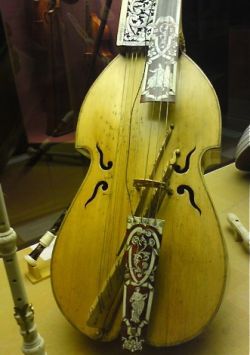 But there are real jolts that make the blood boil - a large baryton of 1720 with Orpheus flying at the top of its neck, across whose body one thick string lies broken and ugly, Orpheus crippled (pictured left). Barytons were among Haydn’s favourite instruments.
But there are real jolts that make the blood boil - a large baryton of 1720 with Orpheus flying at the top of its neck, across whose body one thick string lies broken and ugly, Orpheus crippled (pictured left). Barytons were among Haydn’s favourite instruments.
Also I was told at the information desk that a few instruments will stay in the Renaissance galleries there - but only Italian ones, and only those of that much earlier period. The brilliant German, Dutch, English instruments of Purcell's and Bach's time - no one knows where they will go. The music colleges and little specialist museums are already overburdened and underresourced. I went on that evening to Covent Garden to see the ballet Romeo and Juliet, and a mandolin dance where again another of those sudden associations that museums throw at you - as Juliet played her plywood fake instrument, I wondered whether the V&A mightn't hand over something deliciously old, cherishable, bulbous, unplayable, inlaid with sighs in ivory, little gurgling laughs in bronze, and perhaps a cupid on top, for this eternal pair of lovers.
The argument over this issue is presented too drily: elite music vs vernacular fashion. The V&A's own web page admirably sets out the importance and purpose of the collection, primarily decorative and technological. And besides, the fashion that's neglected there is apparently not the fast-moving modern stuff but the perishable fashion of those instruments' periods. Face it, these instruments are extraordinary testimony of the irrational greatness of the human being: the endlessly inquiring perfectionism in an essentially useless, yet utterly essential pursuit - the pursuit of beauty. The V&A is being obtuse: this rejection of their musical instruments is a total failure of imagination, which is the worst sin a museum of all places can commit.
Hear the Trio from Haydn's Divertimento for baryton, viola and cello played by Trio Baryton de Madrid:
Conductor and harpsichordist Christopher Hogwood, who has signed the Downing Street petition against the V&A move, discussed the row with Sean Rafferty on Friday on Radio 3's In Tune - hear it again until this Friday (the discussion starts 49 minutes into the programme and includes Trevor Pinnock playing Queen Elizabeth I's spinet at the V&A).
The V&A opens its musical collection in Gallery 40a for the last time on 13 & 14 February, and 19, 20 and 21 February.
Other youtube videos of period instruments typical of the V&A collection:
- Lute played by Nigel North for Naxos (Dowland)
- Archlute played by David Tayler (Bach)
- Theorbo (Bach) - played under still photographs
- Theorbo (Kapsberger's Arpeggiata) played by Kleber Besson
- Spinet, a restored 1712 instrument (plucked strings), in Purcell
- Clavichord, a replica 1670 instrument (struck strings) in Bach/Vivaldi

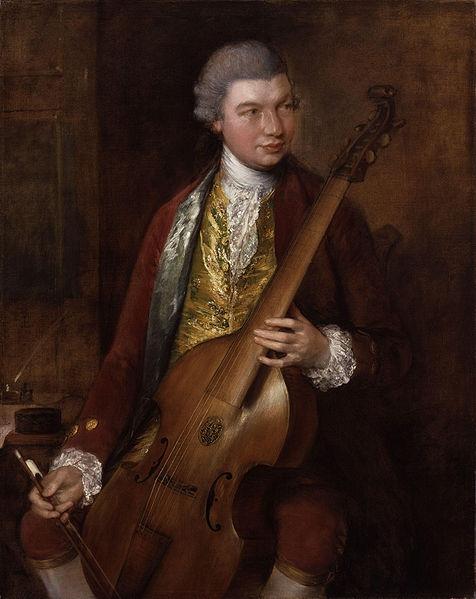











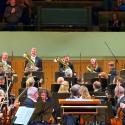
Add comment